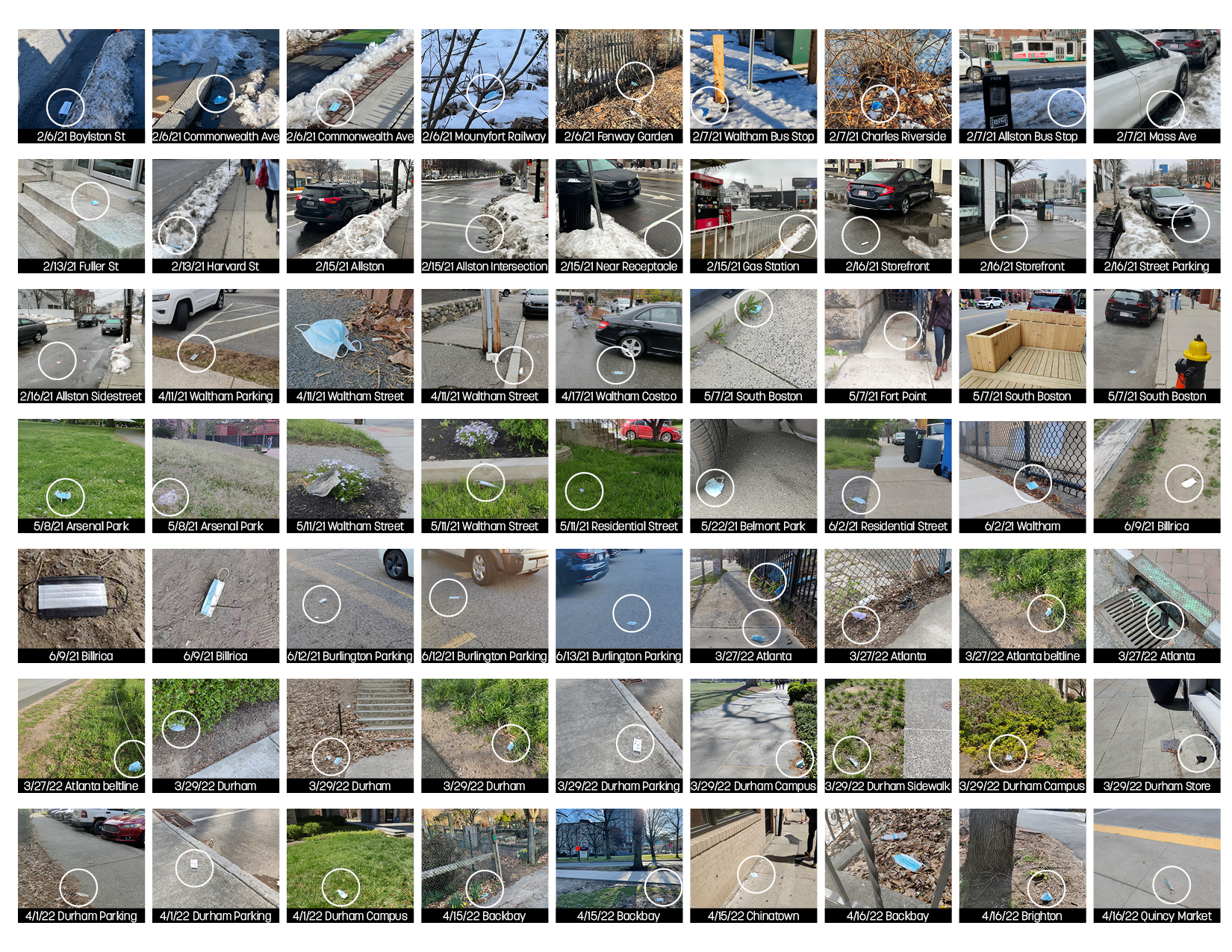Blue Rescue: Using Discarded Masks to Inform Public Space Design

 Sasaki
Sasaki

Discarded masks have become common street trash around the world. So many untreated, contaminated masks pose a risk for public health and the environment. Can designers help solve this new pollution crisis?
By observing patterns of mask litter and proposing design solutions, Sasaki urban designer Tianjiao Zhang, LEED AP ND, PLA and landscape architect Lanmuzhi Yang, ASLA, PLA, LEED AP ND hope to inspire designers to take action. Read on to learn more about their research.
Discarded masks and other protective equipment have become a common new street trash around the world. If you pay attention to the ground, you will likely find masks on sidewalks, in parks, near bus stations, and in parking lots. According to a report of OceanAsia, “The Impact of COVID-19 on Marine Plastic Pollution,” about 1.5 billion face masks likely polluted our oceans in 2020—if these masks were connected end-to-end, the total length of them would circle the earth 75 times.1 These masks pollute marine environments, harm marine life, and eventually cascade up the food chain to us, according to Laurent Seuront, CNRS.2
Research has pointed out that Coronavirus trash has caused a shift in the composition of the litter stream. The good news is that people have already started exploring innovative ways to address the problem of waste. A company called Plaxil in France announced they can recycle the masks and turn them to new plastic products such as face shields and containers;3 and research from the University of Petroleum and Energy Studies in Dehradun, India, has suggested that PPE litter could potentially be used as fossil fuel (although it is still a matter of debate since the emission of the plastic is toxic).4 Regardless of what we can do in the last step of waste management, the consensus is that it is urgent to have an efficient way to collect the PPE litter in the public space first.
Answering this question is not as easy as you might think. The distribution of discarded masks is like a map of human activities. The concentrated areas of those masks vary in different urban spaces but are well aligned with people’s new lifestyle and travel patterns, which are shaped by the pandemic. Therefore, we ask ourselves, can we get a sense of the changes in the social life of urban spaces through observations of discarded masks? Can we develop strategies and guidelines that adapt to these changes to improve our urban spaces?
With that question in mind, we documented discarded masks found on walks throughout 2021 and 2022. We mainly focused on Boston, but also documented trips to Atlanta, New York, Denver, Oklahoma City, and Durham. After observing hundreds of miles of ground, we found over 200 discarded masks, and observed three types of spaces that have the most masks: streets, parks and recreational spaces, and parking spaces. Below are some examples of our observations and improvement suggestions.

Observations of discarded masks in 2021 and 2022
(Photo credit: Tianjiao Zhang and Lanmuzhi Yang)
These streets are characterized by shops, groceries, markets, and restaurants with outdoor dining areas. Diverse transportation methods are provided, including bus stops, subway stations, and bike lanes, which make the streets frequently used by the public. Receptacles can be found in nearly every intersection.

Observations on major mixed-use urban streets
(Photo credit: Tianjiao Zhang and Lanmuzhi Yang)

The parks we observed vary from small pocket open spaces to big city parks, including urban plazas, linear parks, and waterfront open spaces. With looser mask requirements and popularity of vaccines, even though there are less people wearing masks, it is still easy to find discarded masks where there are recreational and gathering opportunities.

Observations of recreational parks
(Photo credit: Tianjiao Zhang and Lanmuzhi Yang)

Parking areas, including street parking and surface parking for restaurants, parks, shopping malls, markets, public transit stations, and campuses, are important transitional spaces that are easily ignored in open space studies. However, more than 30% of masks in our observation were found in parking areas. Street parking and surface parking show different characteristics when masks are taken off.

Observations of parking areas
(Photo credit: Tianjiao Zhang and Lanmuzhi Yang)

Through our observations, we found that most discarded masks stay where people stop. They also travel with the wind, getting trapped in unreachable areas like forests and bodies of water where it is hard to collect them. When masks remain in the environment, they release microfibers5 and may increase the spread of infectious disease. Therefore, we want to encourage proper mask disposal in the public realm through design interventions, to reduce the environmental risk and protect ourselves.
With the popularity of vaccines and the control of the pandemic, Covid-19 will eventually fade away. Masks, however, are here to stay. As we begin to accept masks as a norm, we also accept the waste that comes with them.6 We know masks will remain in our life and stay in our environment for decades, and it’s not too late to take action against the pollution they cause. Even small interventions on the street can be impactful to our planet.
